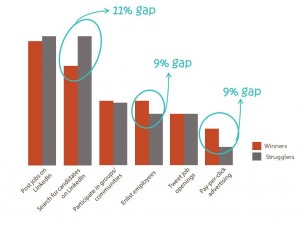Wouldn’t it be great to know what successful recruiters – companies that are finding it easier to find the talent they’re looking for – are doing that may be different from companies that are struggling?
Earlier this year, we surveyed more than 450 HR professionals from around the globe as part of our 2015 McQuaig Global Recruitment Survey, with that exact question in mind (among others).
When we dug into the data that came back we uncovered a number of differences that, put together, paint a picture of what these companies are doing differently.
What the numbers tell us
First, let’s look at what’s happening out there. When we asked whether it was getting easier or more difficult to fill openings; one-third said that it’s harder now to fill positions than it was one year ago. About half (56 percent) said it’s about the same, and just 8 percent said it’s getting easier.
Compared to our survey last year, about the same number (34 percent) felt it was getting harder, but a much smaller percentage (8 percent this year vs. 28 percent in 2014) said it was getting easier.
This suggests to us that a talent shortage may, in fact, be building and starting to have an impact on some segments of the market.
What it takes to be a winner
So, now let’s have a look at how what different groups – those who are finding it easier to fill vacancies and those finding it more difficult – are doing to attract talent. In our report we refer to these two groups as Winners and Strugglers, and that’s how I’ll reference them here.
The number one step that both groups are taking to attract talent in this candidates’ market is investing in training existing employees. The Winners, though, cite this as a strategy 75 percent of the time versus 55 percent for the Strugglers.
Looking at the biggest gaps between the two groups, Winners are also more likely to be offering flexible work arrangements (29 percent vs. 19 percent) and redefining work procedures (29 percent vs. 20 percent). Whereas, the Strugglers are more likely to be experimenting with new recruiting strategies (53 percent vs. 42 percent) and increasing the compensation (32 percent vs. 25 percent).
A different approach to social recruiting
Our Winners were twice as likely to be receiving quality candidates through social recruiting as their counterparts. When we drilled down into how each group was using social media in their recruiting efforts the results suggested why this might be the case.
- Winners are less likely to cite searching for candidates on LinkedIn as a tactic (58 percent vs. 70 percent);
- Winners are more likely to be enlisting employees to promote the company in social channels (35 percent vs. 27 percent);
- Winners are almost twice as likely to use pay-per-click advertising (19 percent vs. 10 percent)
The Winners seem to have a better grasp on how to use social media effectively in the recruitment process. Social media’s strength as a recruiting tool is really in facilitating engagement and building the employer brand.
The companies that are doing it right are developing “employee personas” for their ideal candidates and using social media to develop relationships with those who match the employee persona, not just Tweeting job ads and running LinkedIn searches.
In the survey, 75 percent said they are creating a profile of the ideal candidate as part of the recruiting process. The next step is taking that profile and developing it into a full-blown persona that can be used to target passive candidates. This is the step many of Strugglers (and lots of the Winners) may be missing.
Tips for emulating the winners
Based on the broader findings in the survey (some of which are covered here, some not), we put together a list of tips we think companies should embrace to try to emulate the Winners in our survey:
- Equip your hiring managers to be better at assessing candidates. Get them interview training, provide them with access to assessments that make it easier for them to make the interview count.
- Invest your resources wisely, developing more than one or two channels, don’t put all your eggs in one basket.
- Focus on using social media to recruit passive candidates by utilizing your employees who can be brand ambassadors.
- Create well-developed employee personas to target your audience in social channels.
- Focus on getting more employee referrals. Use formal employee referral programs and social media to increase the flow from this valuable source of quality candidates.
- Experiment with targeted pay-per-click advertising of your content and your job ads, based on a solid ideal candidate profile or “employee persona”
For more the complete results behind these recommendations and all the results, download the complete survey report here.
